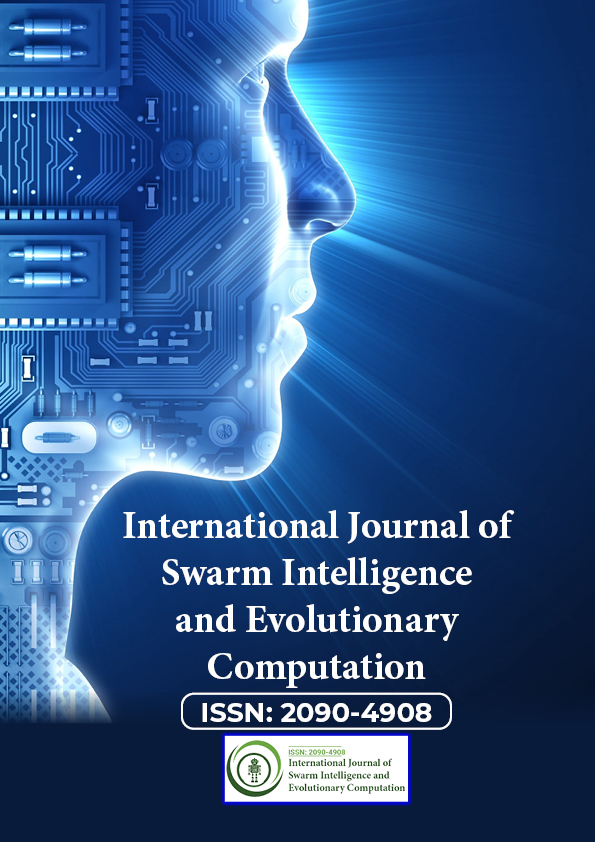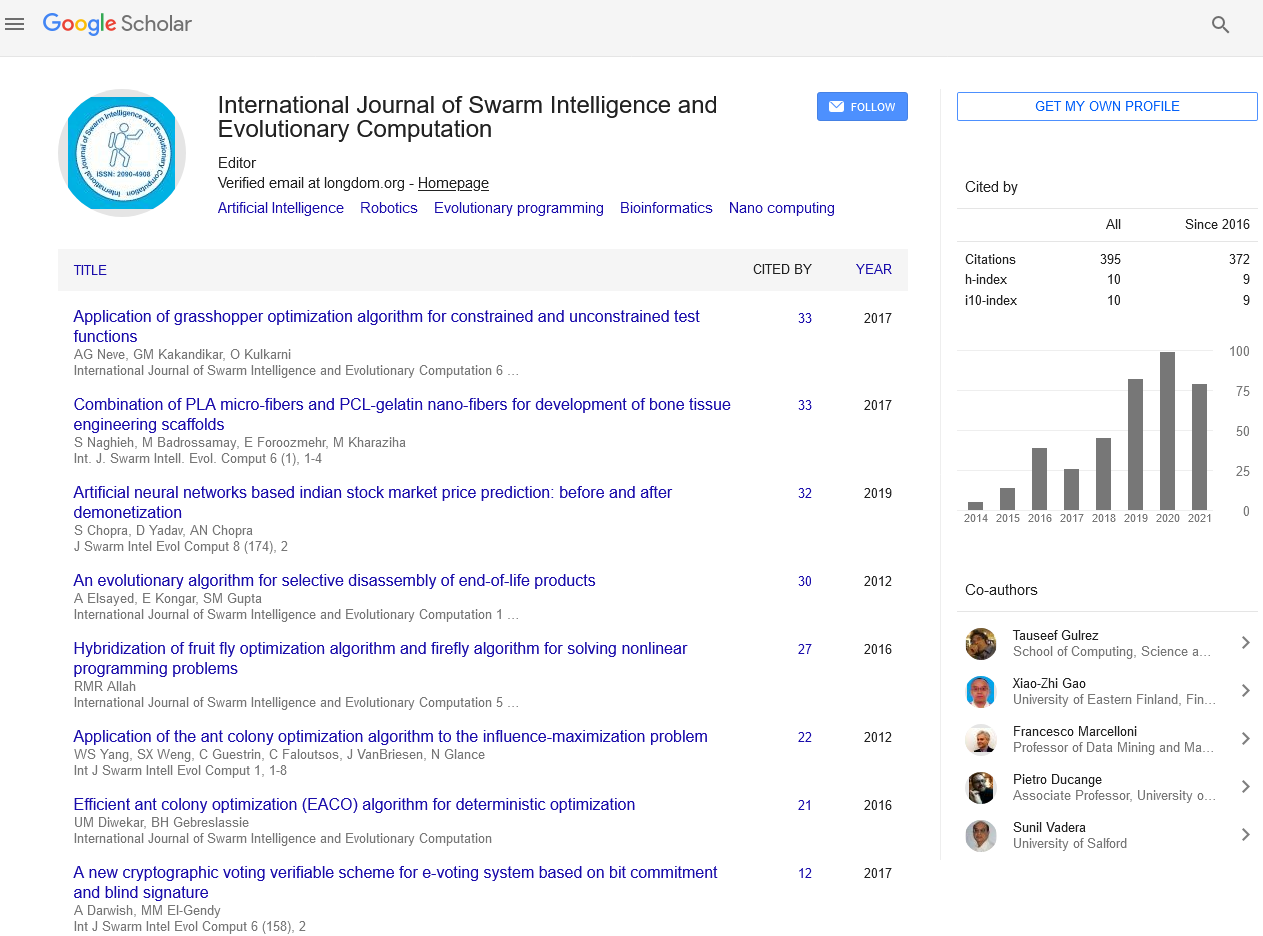Indexed In
- Genamics JournalSeek
- RefSeek
- Hamdard University
- EBSCO A-Z
- OCLC- WorldCat
- Publons
- Euro Pub
- Google Scholar
Useful Links
Share This Page
Journal Flyer

Open Access Journals
- Agri and Aquaculture
- Biochemistry
- Bioinformatics & Systems Biology
- Business & Management
- Chemistry
- Clinical Sciences
- Engineering
- Food & Nutrition
- General Science
- Genetics & Molecular Biology
- Immunology & Microbiology
- Medical Sciences
- Neuroscience & Psychology
- Nursing & Health Care
- Pharmaceutical Sciences
Perspective - (2023) Volume 12, Issue 2
Exploring the Applications and Challenges of Swarm Robotics
Matthew Jude*Received: 22-Feb-2023, Manuscript No. SIEC-23-20959; Editor assigned: 24-Feb-2023, Pre QC No. SIEC-23-20959 (PQ); Reviewed: 10-Mar-2023, QC No. SIEC-23-20959; Revised: 17-Mar-2023, Manuscript No. SIEC-23-20959 (R); Published: 27-Mar-2023, DOI: 10.35248/2090-4908.23.12.309
Description
Swarm robotics is a field of robotics that focuses on the coordination and cooperation of multiple robots to achieve a common goal. Inspired by the collective behavior of social insects such as ants, bees, and termites, swarm robotics aims to replicate their ability to work together in a decentralized and selforganized manner. Swarm robotics has gained increasing attention in recent years due to its potential to revolutionize various industries by providing unique solutions to complex problems that are difficult or impossible for a single robot to accomplish. Swarm robotics has several advantages over traditional robotics, including robustness, scalability, adaptability, and efficiency, making it a promising area of research with numerous applications.Applications of Swarm Robotics
Agriculture
Agriculture is a critical industry that plays a vital role in feeding the growing global population. Swarm robotics has the potential to revolutionize agriculture by improving the efficiency and sustainability of farming practices. For example, swarms of small robots can be used for precision agriculture, where they can autonomously monitor and manage crops by collecting data on soil moisture, nutrient levels, and plant health. These robots can then provide real-time information to farmers, allowing them to make informed decisions about irrigation, fertilization, and pest control, leading to optimized resource usage and increased crop yields.
Swarm robots can also be used for crop pollination. With the decline of natural pollinators such as bees, swarm robots can be deployed to pollinate flowers, ensuring the pollination of crops and maintaining food production. These robots can mimic the behavior of bees, such as flying from flower to flower and transferring pollen, thereby helping to address the issue of declining pollinators and ensuring crop productivity.
Furthermore, swarm robots can be used for weed management in agriculture. By working together, swarm robots can autonomously identify and remove weeds, reducing the need for chemical herbicides and minimizing the environmental impact of weed control.
Construction
Construction is another field that can benefit from swarm robotics. Construction sites are often complex and dynamic environments with multiple tasks that require coordination and cooperation among different robots. Swarm robots can work collaboratively to perform tasks such as material transport, bricklaying, and concrete pouring, leading to increased productivity and reduced labor costs.
Disaster response
Swarm robotics has the potential to greatly impact disaster response scenarios, where time is of the essence and human intervention may be limited or risky. Swarm robots can be deployed to search and rescue victims in disaster-stricken areas, such as collapsed buildings, earthquake sites, or flooded areas. These robots can work autonomously or in coordination with human rescue teams, navigating through debris, and searching for survivors. Swarm robots equipped with cameras, sensors, and communication devices can relay real-time information to rescue teams, aiding in decision-making and improving the chances of finding and saving survivors.
Healthcare
Swarm robotics has the potential to revolutionize healthcare by providing innovative solutions for patient care, monitoring, and medical procedures. Swarm robots can be used for tasks such as patient monitoring, medication delivery, and assistance in surgical procedures. These robots can work in coordination with healthcare professionals to provide efficient and personalized care to patients. For example, swarm robots can monitor patients' vital signs, collect data on their health status, and communicate with healthcare providers to ensure timely medical interventions.
Transportation
Transportation is another field that can greatly benefit from swarm robotics. Swarm robots can be used for tasks such as autonomous vehicles, package delivery, and traffic management. Swarm robots can work collaboratively to optimize traffic flow, reduce congestion, and improve transportation efficiency. For example, swarm robots can communicate with each other and with traffic infrastructure to coordinate movements, adapt routes, and optimize traffic patterns, leading to reduced travel times and improved transportation systems.
Challenges and Future Directions
Although swarm robotics holds great promise for numerous applications, there are several challenges that need to be addressed for its widespread adoption. Some of the challenges include:
Scalability: Scaling up swarm robotics systems to a large number of robots can be challenging. Ensuring robust and efficient coordination among a large number of robots requires advanced algorithms and communication protocols that can handle the increased complexity and scale of the system.
Robustness: Swarm robots need to be robust to uncertainties and environmental changes. Factors such as communication failures, sensor noise, and robot failures can affect the performance of swarm systems. Developing robust algorithms and strategies that can adapt to changing conditions is crucial for the success of swarm robotics.
Citation: Jude M (2023) Exploring the Applications and Challenges of Swarm Robotics. Int J Swarm Evol Comput. 12:309.
Copyright: © 2023 Jude M. This is an open-access article distributed under the terms of the Creative Commons Attribution License, which permits unrestricted use, distribution, and reproduction in any medium, provided the original author and source are credited.


